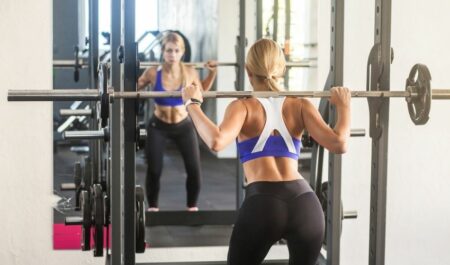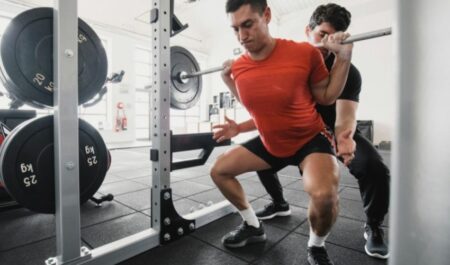Squats are beneficial to everyone, from beginners to advanced fitness lovers to weightlifters to sports. They are a lower-body workout that is both functional and effective. Squats can be performed in a variety of different ways. In this article we are going to collect results about what is the deference between high bar vs low bar squat training.
They can be performed with or without the use of weights. You can use a barbell, dumbbells, kettlebells, or a machine to increase the load and intensity of the exercise, or you can simply utilize your own body weight to increase the load and intensity.
Back squats are performed by placing a bar across your back and lowering yourself into a squat toward the ground while holding the bar.There are two distinct methods to hold the bar: either high on the upper back or lower on the midback.

It’s critical to understand the difference between a high bar position and a low bar position when lifting weights. It has the potential to influence which muscles are worked. Here’s how to determine whether version is most appropriate for your objectives.
What Exactly Is A High Bar Squat?
Known sometimes as a back squat with a high bar, this exercise involves placing the bar on the trapezius muscle over the top of the shoulders. The feet are spaced shoulder-width apart, with the toes pointing outward slightly.
The bar must remain above the midfoot throughout the squat movement in order to maintain balance. As a result of placing the bar high on the back, it is necessary to maintain an upright torso position and forward movement of the knees in order to appropriately drop into the squat position.

What Exactly Is A Low Bar Squat?
During a back squat position, a low bar squat is performed in which the bar is placed low on the upper back, similar to a squat position. It should be resting on the posterior deltoid, not the top of the shoulders, when performing this exercise.
It is important to note that the feet are also shoulder-width apart and slightly out for this maneuver. If you want to stay balanced and maintain a straight bar path over your midfoot while in this squat position, you must instantly bend slightly at the hips. This forces the torso to tilt more forward throughout the movement in order to avoid falling backward.

The Advantages Of Performing A High Bar Squat.
It is important to have strong quadriceps when performing this sort of squat. It’s a good exercise to do if you want to build strength and muscular mass in your quadriceps, which are the muscles that run down the front of your legs.
Those who have good ankle mobility will benefit the most from this exercise, as the knees must go further than the ankles in order to drop down into a squat position.
In addition, it puts less strain on the lower back and makes it easier to maintain balance than a low bar squat does. The bar is naturally placed over the midfoot from the beginning of the movement.
The Advantages Of Performing A Low Bar Squat.
This type of squat concentrates the work on the posterior chain of muscles, which includes the glutes, hamstrings, and back extensors, rather than the anterior chain.
With this position, less stress is placed on the quadriceps and more emphasis is placed on the muscles of the posterior chain. As a result, it is great for those who want to strengthen their glutes while also improving the function of their hamstrings.
This version recruits more muscles than the previous edition. Low bar squats allow some people to lift larger weights, allowing them to maximize their strength increases as a result of the exercise.
In addition, a low bar squat may be beneficial for people who have restricted ankle mobility because the knees do not have to travel as far in front of the ankles as they would otherwise, reducing the amount of flexion.
The Bottom Line.
Both forms of squats are effective for achieving distinct objectives. If you want to boost your power and strength in other exercises, like as power cleans and snatches, a high bar squat may be the best option.
It’s possible that a low bar squat is right for you if you want to improve the muscles in your posterior chain, increase your one-rep max, and challenge your balance and core strength all at the same time.
Many people do not have the shoulder mobility and balance necessary to maintain good position throughout a low bar squat, which is a disadvantage of this type of exercise.
When poor body mechanics are paired with a big load, the likelihood of injury increases dramatically.
